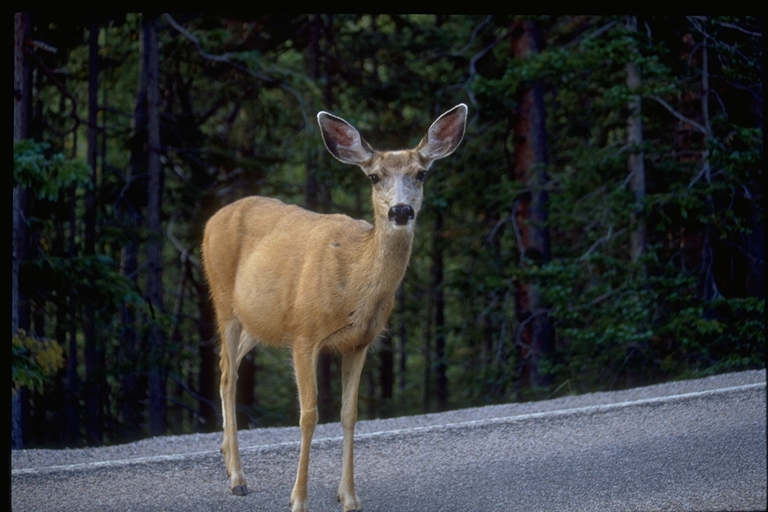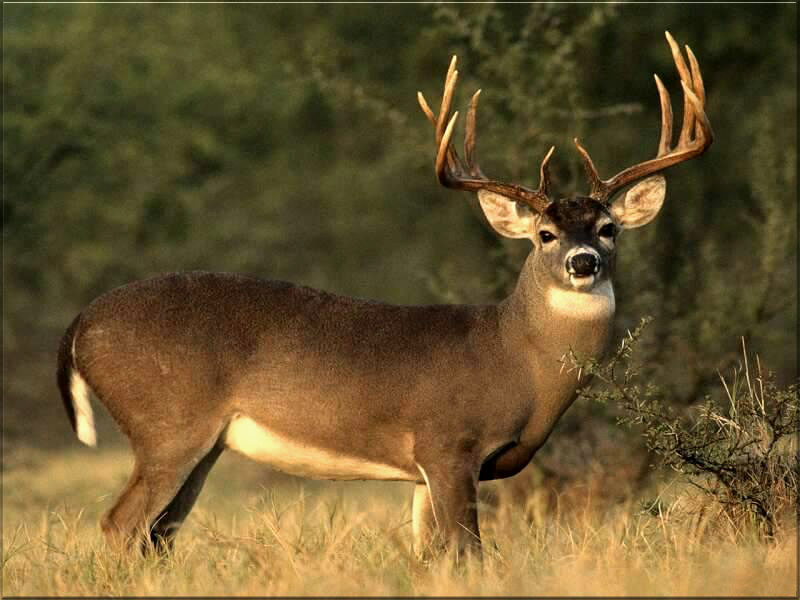Other: Other Related Research
Mule Deer
By Alexandra Glaser (04/30/09 01:22:03)
Related animal: Mule Deer
Geography: Found in the Western Half of North America, generally West of the Missouri River. Mule deer prefer "edge" habitats where the trees meet the grass.
Visual Description: Mule Deer have large ears that move constantly and independently, from whence they get their name, "Mule" or "Burro Deer." Mule Deer are usually a dark gray-brown, with a small white rump patch and a small, black-tipped tail. This stocky deer with sturdy legs is 4 to 6-1/2 feet in length and 3 to 3-1/2 feet high at the shoulder.
Antlers: Mule deer antlers are bifurcated, or "fork" as they grow. The bucks' antlers, which start growth in spring and are shed around December each year, are high and branch forward with a spread of up to 4 feet. Antlers are shed after the breeding season, from mid-January to about mid-April. Dominance in the mule deer community is largely a function of size, therefore, the largest males which possess the largest antlers perform the most copulations during mating season.
Movement: They do not run as other deer, but have a peculiar and distinctive bounding leap (stotting) over distances up to 8 yards, with all 4 feet coming down together. In this fashion, they can reach a speed of 45 m.p.h. for short periods. This gait offers two advantages: it allows the deer to out-distance predators in rough terrain, and to see above the thick brush. If necessary, they can turn or completely reverse direction in the course of a single bound.
Feeding Behavior: In Spring and Summer it feeds on green leaves, herbs, weeds and grasses more than on browse species. The reverse is true in Fall and Winter. Mule Deer are browsers and eat a great variety of vegetable matter, including fresh green leaves, twigs, lower branches of trees, and various grasses. They are particularly fond of blackberry and raspberry vines, grapes, mistletoe, mushrooms and ferns.
Daily Behavior: Mule deer of both sexes normally do most of their feeding in early morning before sunrise or in late afternoon and evening after sundown. They spend the middle of the day bedded down in cool, secluded places. In summer, the bucks retire as soon as the sun shines where they are feeding and go to the dense shade of some grove to bed down for the day. This inactivity during the heat of the day is a behavioral adaptation to the desert environment that conserves water and keeps the body temperature within livable limits. Sweat glands and panting also provide evaporative cooling during hot periods.
Vocalization: Deer are not especially vocal, although young fawns bleat on occasion. Injured deer utter a startlingly loud "blatt" or bawl.
Smell: Although equipped with acute senses of sight and hearing, these deer rely largely upon the sense of smell in detecting danger
Sight: Stationary objects are easily overlooked by them, but they readily detect any that are in motion
Hearing: The Mule Deer sense of hearing is extremely acute.
Play behaviors: Mule Deer is an excellent swimmer, but water is rarely used as a means of escaping predators
Hunting: Mule deer are of considerable economic importance as a big game mammal and sport hunters kill about 1 million Mule Deer annually
Etc: Another physical adaptation, its larger feet, allows the Mule Deer to claw out water as much as two feet deep
Video of calling to a mule deer:
http://www.youtube.com/watch?v=XdVmI1IUPX4
[Write Comment]
By Alexandra Glaser (04/30/09 01:22:03)
Related animal: Mule Deer
Geography: Found in the Western Half of North America, generally West of the Missouri River. Mule deer prefer "edge" habitats where the trees meet the grass.
Visual Description: Mule Deer have large ears that move constantly and independently, from whence they get their name, "Mule" or "Burro Deer." Mule Deer are usually a dark gray-brown, with a small white rump patch and a small, black-tipped tail. This stocky deer with sturdy legs is 4 to 6-1/2 feet in length and 3 to 3-1/2 feet high at the shoulder.
Antlers: Mule deer antlers are bifurcated, or "fork" as they grow. The bucks' antlers, which start growth in spring and are shed around December each year, are high and branch forward with a spread of up to 4 feet. Antlers are shed after the breeding season, from mid-January to about mid-April. Dominance in the mule deer community is largely a function of size, therefore, the largest males which possess the largest antlers perform the most copulations during mating season.
Movement: They do not run as other deer, but have a peculiar and distinctive bounding leap (stotting) over distances up to 8 yards, with all 4 feet coming down together. In this fashion, they can reach a speed of 45 m.p.h. for short periods. This gait offers two advantages: it allows the deer to out-distance predators in rough terrain, and to see above the thick brush. If necessary, they can turn or completely reverse direction in the course of a single bound.
Feeding Behavior: In Spring and Summer it feeds on green leaves, herbs, weeds and grasses more than on browse species. The reverse is true in Fall and Winter. Mule Deer are browsers and eat a great variety of vegetable matter, including fresh green leaves, twigs, lower branches of trees, and various grasses. They are particularly fond of blackberry and raspberry vines, grapes, mistletoe, mushrooms and ferns.
Daily Behavior: Mule deer of both sexes normally do most of their feeding in early morning before sunrise or in late afternoon and evening after sundown. They spend the middle of the day bedded down in cool, secluded places. In summer, the bucks retire as soon as the sun shines where they are feeding and go to the dense shade of some grove to bed down for the day. This inactivity during the heat of the day is a behavioral adaptation to the desert environment that conserves water and keeps the body temperature within livable limits. Sweat glands and panting also provide evaporative cooling during hot periods.
Vocalization: Deer are not especially vocal, although young fawns bleat on occasion. Injured deer utter a startlingly loud "blatt" or bawl.
Smell: Although equipped with acute senses of sight and hearing, these deer rely largely upon the sense of smell in detecting danger
Sight: Stationary objects are easily overlooked by them, but they readily detect any that are in motion
Hearing: The Mule Deer sense of hearing is extremely acute.
Play behaviors: Mule Deer is an excellent swimmer, but water is rarely used as a means of escaping predators
Hunting: Mule deer are of considerable economic importance as a big game mammal and sport hunters kill about 1 million Mule Deer annually
Etc: Another physical adaptation, its larger feet, allows the Mule Deer to claw out water as much as two feet deep
Video of calling to a mule deer:
http://www.youtube.com/watch?v=XdVmI1IUPX4

| 
|